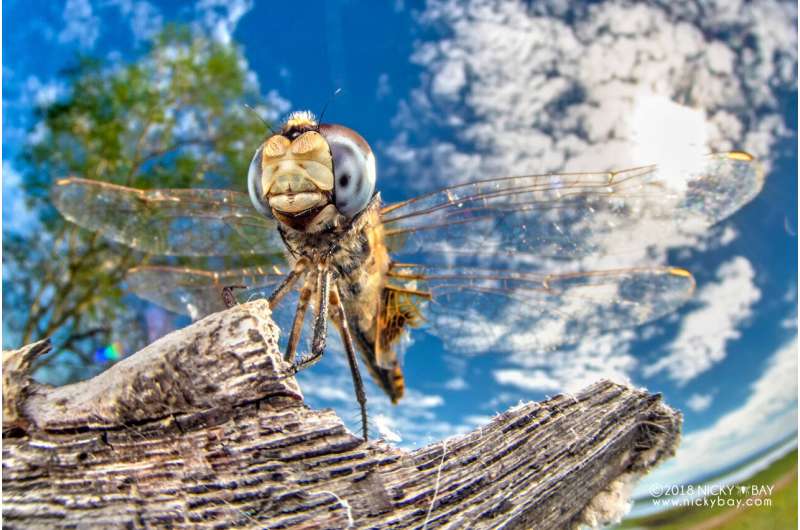
Credit: Nicky Bay, provided, used with permission
A groundbreaking study, led by Dr. Mark Wong of The University of Western Australia, has provided the first global picture of insect activity patterns across the fundamental day–night cycle.
“Through our extensive research, we’ve finally been able to provide a definitive answer to the age-old question of whether there are more insects out at night than during the day,” said Dr. Wong. “Our global analysis not only shows that insect activity rises by a third (31.4%) during the night on average, but crucially reveals key ecological factors driving patterns in insect activity across the Earth.”
The activity patterns of insects across the day–night cycle are a surprisingly understudied area in ecology, as such patterns cannot be detected by common methods used for sampling insects. For example, sweep netting captures inactive insects, while light traps do not work as well during the day as they do during the night.
The researchers overcame this challenge by identifying studies that sampled insects during the day and night with traps that specifically caught moving insects, such as pitfall traps, flight interception traps, and aquatic drift nets.
After meticulously combing through thousands of studies, they identified 99 studies spanning from 1959 to 2022, which had used these methods to document insect activity patterns across diverse landscapes, from tropical jungles to temperate forests, arid grasslands and aquatic ecosystems. The total number of insects observed exceeded 3 million individuals.
The results of the study, published in the journal Nature Communications, reveal multiple ecological factors that shape insect activity patterns across the globe.
Multiple insect groups such as mayflies, caddisflies, moths, and earwigs, were found to be more abundant during the night. Conversely, daytime saw increased activity among thrips, bees, wasps, and ants.
Nocturnal activity was also more common in rivers and streams. In these aquatic habitats, there could be twice as many insects active during the night. In contrast, land-based insects generally had higher diurnal activity, especially in grasslands and savannas, where the number of insects out and about could triple during the day.
Credit: Nicky Bay, provided, used with permission
Dr. Wong said these contrasting patterns in terrestrial and aquatic ecosystems may reflect strategies for predator avoidance. “Fish tend to hunt aquatic insects during the day, whereas nocturnal animals such as bats make life on land more hazardous at night.”
The analysis also highlighted the influence of environmental factors, such as temperature, on insect activity at the global scale. “We found peak levels of nocturnal activity in the warmer regions of the world, as more insects likely sought refuge from the heat of the day,” said Dr. Wong.
However, the study also sounded a warning on the threats facing insects, emphasizing the importance of conservation efforts.
“Our findings point to the threat of global warming. In the hottest regions in the world such as the tropics, the warming trend may further reduce the activity of nocturnal insects that are already struggling to cope with heat. On top of that, artificial lighting is detrimental to nocturnal insects, disrupting their natural behaviors in ecosystems.”
Insects perform many vital “ecosystem services” such as pollination, nutrient cycling and pest control. Many of these services may be provided at night, when more insects are active.
Dr. Wong spoke to the lasting value of ecological fieldwork to better understand insect activity patterns. “Such research can be exhausting, as traps need to be installed and replaced multiple times over days and nights, across many different locations.
“But it is absolutely indispensable. Insects are among the most diverse and important organisms on our planet, and studying their intricate rhythms represents not just a scientific endeavor, but an imperative for conserving biodiversity on a rapidly changing planet.”
More information:
Mark K. L. Wong et al, Global meta-analysis reveals overall higher nocturnal than diurnal activity in insect communities, Nature Communications (2024). DOI: 10.1038/s41467-024-47645-2
Citation:
Global study shows a third more insects come out after dark (2024, April 27)
retrieved 28 April 2024
from https://phys.org/news/2024-04-global-insects-dark-1.html
This document is subject to copyright. Apart from any fair dealing for the purpose of private study or research, no
part may be reproduced without the written permission. The content is provided for information purposes only.
>>> Read full article>>>
Copyright for syndicated content belongs to the linked Source : Phys.org – https://phys.org/news/2024-04-global-insects-dark-1.html
